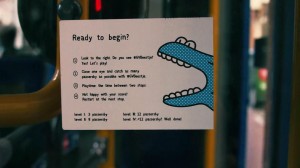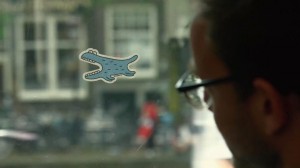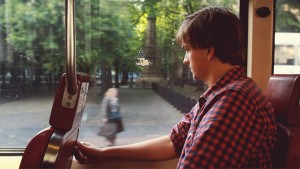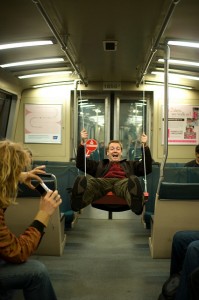Daniel Disselkoen commuted for 4 years during his time at the Royal Academy of Art by tram. Then, he decided to add a little something to change his and his fellow traveler’s daily commute. He created a mind game called the “man-eater”. The objective of the activity is to make the cartoon sticker
eat as many heads of people passing by into ‘the man-eaters’ mouth.
“Why would you look out the window with curiosity when there is no reason to expect anything new?”
—-Daniel Disselkoen
In the recent years, there is a rise in incorporating “playfulness” in public space by creating and injecting urban play elements, just like Disselkoen’s man-eater. These urban interventions allow people to have fun, to feel, and to observe. At the essence of it, is to see the city as playground and to really experience, and maybe transform it, through the act of play.
Being a commuter for years myself, I would be very intrigued to play this game. As I’m already staring at the window, the man-eater might just provide me with a fun perspective to view the landscape through the window.
Some more projects that makes the everyday a little more playful:
Pop-up guerrilla swings (by Bruno Taylor, etc.)

Basket bin (by Collectiv DC)

Slide to the train (by HIK Ontwerpers)

“We don’t stop playing because we grow old; we grow old because we stop playing.”—George Bernard Shawn
Read more:
Stroll: Psychogeographic Walking Tours of Toronto
“Stroll celebrates Toronto’s details – some subtle, others grand – at the speed of walking and, in so doing, helps us to better get to know its many neighbourhoods, taking us from well-known spots like the CN Tower and Pearson Airport to the overlooked corners of Scarborough and all the way to the end of the Leslie Street Spit in Lake Ontario.”
The urban sketcher : techniques for seeing and drawing on location
“Make the world your studio! Capture the bustle and beauty of life in your town. Experience life as only an artist can! Join the rapidly growing, international movement of artists united by a passion for drawing on location in the cities,
towns and villages where they live and travel. Packed with art and advice from Marc Taro Holmes , artist and co-founder of Urbansketchers.org , this self-directed workshop shows you how to draw inspiration from real life and bring that same excitement into your sketchbook.”
Crow Planet: Essential Wisdom from the Urban Wilderness
 “‘Crow Planet’ richly weaves Haupt’s own ‘crow stories’ as well as scientific and scholarly research and the history and mythology of crows, culminating in a book that is sure to make readers see the world around them in a very different way.”
“‘Crow Planet’ richly weaves Haupt’s own ‘crow stories’ as well as scientific and scholarly research and the history and mythology of crows, culminating in a book that is sure to make readers see the world around them in a very different way.”
The urban bestiary : encountering the everyday wild
“Haupt’s observations bring compelling new questions to light: Whose ‘home’ is this? Where does the wild end and the city begin? And what difference does it make to us as humans living our everyday lives? In this wholly original blend of science, story, myth, and memoir, Haupt draws us into the secret world of the wild creatures that dwell among us in our urban neighborhoods, whether we are aware of them or not. With beautiful illustrations and practical sidebars on everything from animal tracking to opossum removal, The Urban bestiary is a lyrical book that awakens wonder, delight, and respect for the urban wild, and our place within it”
City farmer : adventures in urban food growing
“City Farmer celebrates the new ways that urban dwellers across North America are reimagining cities as places of food production. From homeowners planting their front yards with vegetables to guerilla gardeners scattering seeds in neglected urban corners, gardening guru Lorraine Johnson chronicles the increasing popularity of innovative urban food growing.”
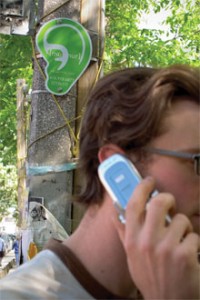 “[murmur] is a documentary oral history project that records stories and memories told about specific geographic locations. We collect and make accessible people’s personal histories and anecdotes about the places in their neighborhoods that are important to them.”
“[murmur] is a documentary oral history project that records stories and memories told about specific geographic locations. We collect and make accessible people’s personal histories and anecdotes about the places in their neighborhoods that are important to them.”
 “100In1Day has the power to inspire citizen involvement by bringing people together for change—having the power to motivate leaders to consider new approaches to problems it aids in producing ideas that can grow beyond just one day.”
“100In1Day has the power to inspire citizen involvement by bringing people together for change—having the power to motivate leaders to consider new approaches to problems it aids in producing ideas that can grow beyond just one day.”
